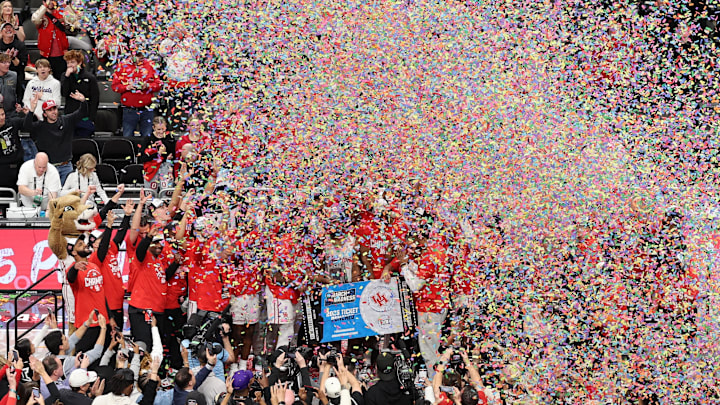The official Big 12 coaches poll is out, but let’s be honest, that’s only half the story. Coaches might have their say, but now it’s time for the real debate to begin. Welcome to the Busting Brackets Big 12 Basketball Power Rankings for the 2025-26 season, where we sort through the hype, the newcomers, and the preseason noise to find out who’s really ready to rule the toughest league in college basketball.
From Houston’s quest for a three-peat to Kansas’ revenge tour and BYU’s youth movement, the Big 12 looks absolutely loaded from top to bottom. So grab your brackets early, here’s how every team stacks up before the first tip of the season.
1. Houston Cougars
It’s rinse, wash, and repeat for Kelvin Sampson’s Cougars. Houston remains one of the toughest, most physical teams in the nation, capable of shutting down anyone defensively. The roster is stacked with athletic, versatile players who can create scoring chances in multiple ways. With Sampson’s proven leadership and two straight Big 12 titles already under their belt, a three-peat feels well within reach.
2. Kansas Jayhawks
After last season’s struggles, Bill Self’s Jayhawks enter with renewed energy and fresh faces. Flory Bidunga will get the spotlight in the frontcourt, while Mevlin Council Jr. provides veteran scoring punch. The biggest buzz surrounds freshman sensation Darryn Peterson, the top recruit in the country and a likely NBA lottery pick. Expect Kansas to fight its way back into national title contention.
3. BYU Cougars
Kevin Young’s BYU Cougars are built around elite potential. With AJ Dybantsa, a projected No. 1 overall pick in the 2026 NBA Draft, joining returners Richie Saunders and Keba Keita, the talent is undeniable. The question is how quickly Young’s squad can mesh and handle the Big 12’s weekly grind.
4. Texas Tech Red Raiders
JT Toppin headlines the Red Raiders after averaging 18.2 points last season. With help from LeJuan Watts, Donovan Atwell, and Luke Bamboye, Texas Tech remains a tough matchup every night. The loss of Darrion Williams hurts, but the program’s depth and toughness under Grant McCasland make them a legitimate top-four team.
5. Arizona Wildcats
Even without Caleb Love, the Wildcats are dangerous. Jaden Bradley and Tobe Awaka form a strong duo for Tommy Lloyd’s squad, which continues to reload with high-level talent. Arizona’s transition into the Big 12 has only toughened them — expect them to contend in the upper half once again.
6. Baylor Bears
Scott Drew’s Bears have plenty of new talent to mold. Oregon State transfer Michael Rataj joins Obi Agbim from Wyoming and Dan Skillings Jr. from Cincinnati. The challenge will be chemistry, but the ceiling remains high. Drew’s track record of building winning rosters means Baylor won’t stay quiet for long.
7. Iowa State Cyclones
The Cyclones return Joshua Jefferson, Tamin Lipsey, and Milan Momcilovic, giving them a solid core. Portal additions Dominick Nelson and Blake Buchanan add depth. As always, defense and effort define this program, but they’ll need Lipsey to carry a bigger offensive load to stay near the top tier.
8. Kansas State Wildcats
After a rocky year in the portal, Kansas State will look to rebuild around PJ Haggerty and Bowling Green transfer Marcus Johnson. The frontcourt remains a major concern, especially in a league this physical. Jerome Tang’s crew has talent, but it’s raw.
9. TCU Horned Frogs
Jamie Dixon has hit the reset button with a new-look backcourt. Iowa transfer Brock Harding could be a bright spot, but there are too many unknowns to place the Frogs higher. Consistency will be key for a program used to flying under the radar.
10. Cincinnati Bearcats
With Jizzle James gone, the Bearcats turn to Kerr Kriisa — a Kentucky transfer who’ll need to rediscover his rhythm. Seven-footer Moustapha Thiam joins from UCF to give Cincinnati a defensive presence inside. The talent is there, but cohesion will take time.
11. Oklahoma State Cowboys
Seton Hall transfer Isaiah Coleman will be asked to do a lot for the Cowboys after averaging nearly 16 points last year. He’ll have the green light, but unless others step up, Oklahoma State may struggle to climb the standings.
12. Central Florida Knights
Johnny Dawkins’ team is almost entirely new. Themus Fulks, Riley Kugel, and George Beale arrive from different programs, and the challenge will be chemistry. Competing against battle-tested Big 12 teams won’t be easy, but this group has upside if it gels early.
13. Colorado Buffaloes
Returning players Bongot Dak, Elijah Malone, and Sebastian Rancik bring some stability, while UC Riverside transfer Barrington Hargress adds scoring. Still, the backcourt is a concern, and Colorado’s youth could show early against elite competition.
14. Arizona State Sun Devils
Bobby Hurley’s seat is warming. Transfers Moe Odum and Adante Holiman will join Marcus Adams Jr., a promising talent from Cal State Northridge. It’s a major rebuild, and patience will be needed as the Sun Devils navigate the new Big 12.
15. West Virginia Mountaineers
New coach Ross Hodge brings pieces from North Texas, including Brenen Lorient, who averaged nearly 12 points last year. This will be a transition year for the Mountaineers, and growing pains are expected.
16. Utah Utes
The Utes lose key contributor Babacar Faye to injury, leaving a massive hole. Guard Terrence Brown, a 20-point scorer at Fairleigh Dickinson, could provide some fireworks, but overall depth remains an issue. Utah’s backcourt has potential, but their front line will struggle in this rugged conference.
